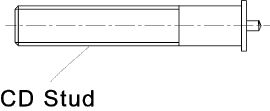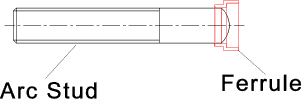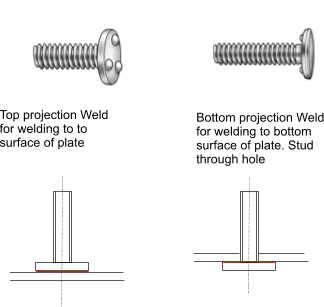| These Pages include various standards. To confirm the status of any standard, identify the replacement standard if it is obsolete and/or purchase the standard please use. It is also possible to become a BSI member and obtain copies of the Standards at much reduced prices. |
Screws Index Page...
Studs /Stud bolts / Weld Studs /Weld Bolts
Introduction The notes below relate to studs/stud bolts, and to stud welding using weld studs. These are widely used engineering components with real advantages compared to other fastener types used for the same applications. The notes are primarily applicable to carbon steel components to the relevant British Standards. In fact the studs and weld studs are available in a wide range of materials to various national and international specifications. Studbolts are often manufactured to very high specifications for the more exotic industries e.g aerospace / off shore applications. These notes shoud therefore only be considered as introductory. For actual detail design applications it is recommended that relevant suppliers are consulted. Studs / StudboltsRelevant British Standards
An important application form this type of fastening is for internal combustion engine cylinder blocks. The cylinder head is normally fastened to the cylinder block using stud bolts. The studs are fitted onto engineered tapped holes in the block. The projecting studs are convenient guides for locating the associated holes in the cylinder head . The head is fastened down using nuts on the studbolts. This type of assembly is also used for special flanges, tank lids, pressure vessel inspection covers, and car wheels. With stud fastening the nut has the ability to "float" and adjust on the nut end threads, which is not possible on a bolt...when fastening into deep tapped hole, this feature becomes even more important.
Studs are used with anchor fixings in civil and architectural engineering and when fastening machinery
to concrete flooring.
Metal End-- End screwed into component. This is generally 1 or 1,5 x the nominal diameter as specified by purchaser. Threads Notes According to the referenced standard the threads on the nut end and on the metal end shall be in accordance with BS 3643 parts 1-3. The nut end shall be to the tolerance 6g (medium fit.). This is as normal for a general bolt. The metal end shall be to the tolerance of a close fit (4h) or an oversize tolerance as specified in the standard BS 4439. The tapped hole shall be to the tolerance 4H or, if it is not critical application a medium 6H tolerance can apply. Stud Strength Classes The strength grade of the stud can be any one of the grades 4,8 / 5,8 / 6,8 / 8,8 / 10,9 /
12,9 / 14,9 The first digit
is the ultimate strength Rm in kgf/mm2. the second digit after the comma is the ratio of [the yield strength (Re)
or the 0,2% proof stress (R0,2 ) for 8,8 grades and above ] to
the the ultimate strength. e.g 4,8 is a steel with an ulitmate strength of 4 kgf/mm2 and a yield strength o 3,2 kgf/ mm2 Weld studs Relevant British Standards BS 7670-1:1993..Steel nuts and bolts for resistance projection welding. Specification for dimensions and properties BS EN ISO 14555:2006... Welding. Arc stud welding of metallic materials For low duty applications for thin plate and sheet steel assemblies the weld stud provides a convenient reliable method of fastening flanged joints and removable covers. The stud welding procedure simply involves positioning a special stud against the flange face using a special welding gun. The gun is operated and the stud is automatically welded to the face..Typical Applications include... Material Handling and Conveyors, Lifts, Metal Furniture, Transportation, Construction and General Machinery. The advantages and disadvantages of the welding stud joint are listed below..
The two main stud welding processes are Capacitor Discharge method (CD) and the Arc Stud Weld Process Capacitor Discharge method Capacitor Discharge (CD) stud welding is generally used to weld smaller diameter fasteners to thin base metals. Because the weld cycle is completed in milliseconds, welds can be made without distortion or burn-through . As long as one end of the fastener is designed for CD welding, CD studs can be manufactured in various shapes. To use CD Studwelding, the parent material must be clean and flat. The sheet may be Mild Steel, Stainless Steel, Aluminium Alloy, Pure Aluminium or Lead Free Brass.
Arc stud welding is generally used to weld large diameter fasteners to rougher and thicker base metals. Arc studs may be almost any shape and there are literally hundreds, however, they must have one end of the fastener designed for Arc welding. Mild steel, stainless steel, and aluminum are applicable materials for Arc stud welding.
Arc stud welding is generally used to weld large diameter fasteners to rougher and thicker base metals. Arc studs may be almost any shape and there are literally hundreds, however, they must have one end of the fastener designed for Arc welding. Mild steel, stainless steel, and aluminum are applicable materials for Arc stud welding. Weld Bolts - ref BS 7670 parts 1& 2.Weld bolts and weld nuts are welded to the base plate using the arc process and the process is facilitated by have projections on the face to be welded. See figure below.
|
Sites Providing Information On Studs
|
|
Screws Index Page...
Please Send Comments to Roy Beardmore




